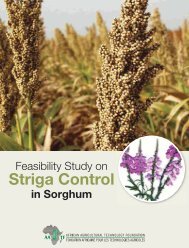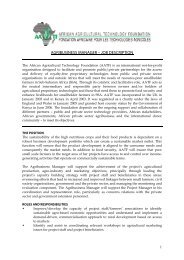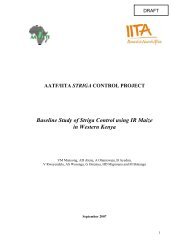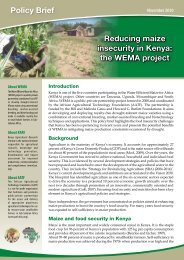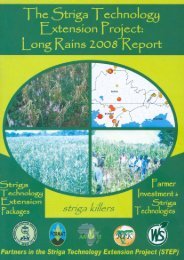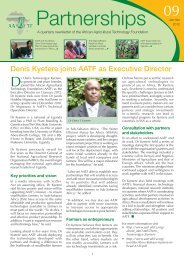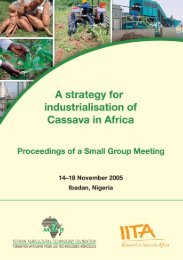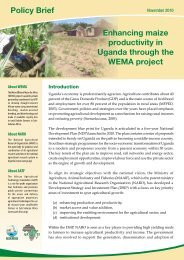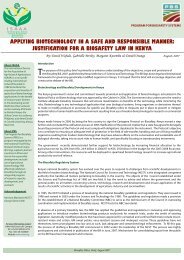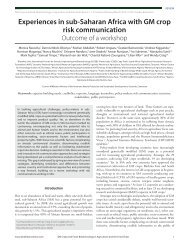Plant Variety Protection Act and Regulations and Rules of Practice
Plant Variety Protection Act and Regulations and Rules of Practice
Plant Variety Protection Act and Regulations and Rules of Practice
Create successful ePaper yourself
Turn your PDF publications into a flip-book with our unique Google optimized e-Paper software.
(6) PUBLICLY KNOWN VARIETIES.-<br />
(A) IN GENERAL.-A variety that is adequately described by a publication reasonably<br />
considered to be a part <strong>of</strong> the public technical knowledge in the United States shall be<br />
considered to be publicly known <strong>and</strong> a matter <strong>of</strong> common knowledge.<br />
(B) DESCRIPTION.-A description that meets the requirements <strong>of</strong> subparagraph (A) shall<br />
include a disclosure <strong>of</strong> the principal characteristics by which a variety is distinguished.<br />
(C) OTHER MEANS.-A variety may become publicly known <strong>and</strong> a matter <strong>of</strong> common<br />
knowledge by other means. (7 U.S.C. 2401.)<br />
Sec. 42. Right to <strong>Plant</strong> <strong>Variety</strong> <strong>Protection</strong>; <strong>Plant</strong> Varieties Protectable. 16<br />
(a) IN GENERAL.-The breeder <strong>of</strong> any sexually reproduced or tuber propagated plant variety (other than fungi<br />
or bacteria) who has so reproduced the variety, or the successor in interest <strong>of</strong> the breeder, shall be entitled<br />
to plant variety protection for the variety, subject to the conditions <strong>and</strong> requirements <strong>of</strong> this <strong>Act</strong>, if the<br />
variety is-<br />
(1) new, in the sense that, on the date <strong>of</strong> filing <strong>of</strong> the application for plant variety protection,<br />
propagating or harvested material <strong>of</strong> the variety has not been sold or otherwise disposed <strong>of</strong> to<br />
other persons, by or with the consent <strong>of</strong> the breeder, or the successor in interest <strong>of</strong> the breeder, for<br />
purposes <strong>of</strong> exploitation <strong>of</strong> the variety-<br />
(A) in the United States, more than 1 year prior to the date <strong>of</strong> filing; or<br />
(B) in any area outside <strong>of</strong> the United States-<br />
(i) more than 4 years prior to the date <strong>of</strong> filing, except that in the case <strong>of</strong> a tuber<br />
propagated plant variety the Secretary may waive the 4-year limitation for a period<br />
ending 1 year after the date <strong>of</strong> enactment <strong>of</strong> the Federal Agriculture Improvement<br />
<strong>and</strong> Reform <strong>Act</strong> <strong>of</strong> 1996; or<br />
(ii) in the case <strong>of</strong> a tree or vine, more than 6 years prior to the date <strong>of</strong> filing;<br />
(2) distinct, in the sense that the variety is clearly distinguishable from any other variety the<br />
existence <strong>of</strong> which is publicly known or a matter <strong>of</strong> common knowledge at the time <strong>of</strong> the filing<br />
<strong>of</strong> the application;<br />
(3) uniform, in the sense that any variations are describable, predictable, <strong>and</strong> commercially<br />
acceptable; <strong>and</strong><br />
(4) stable, in the sense that the variety, when reproduced, will remain unchanged with regard to the<br />
essential <strong>and</strong> distinctive characteristics <strong>of</strong> the variety with a reasonable degree <strong>of</strong> reliability<br />
commensurate with that <strong>of</strong> varieties <strong>of</strong> the same category in which the same breeding method is<br />
employed.<br />
(b) MULTIPLE APPLICANTS.-<br />
(1) IN GENERAL.- If 2 or more applicants submit applications on the same effective filing date for<br />
varieties that cannot be clearly distinguished from one another, but that fulfill all other<br />
requirements <strong>of</strong> subsection (a), the applicant who first complies with all requirements <strong>of</strong> this <strong>Act</strong><br />
shall be entitled to a certificate <strong>of</strong> plant variety protection, to the exclusion <strong>of</strong> any other applicant.<br />
(2) REQUIREMENTS COMPLETED ON SAME DATE.-<br />
(A) IN GENERAL.-Except as provided in subparagraph (B), if 2 or more applicants comply<br />
with all requirements for protection on the same date, a certificate shall be issued for<br />
each variety.<br />
(B) VARIETIES INDISTINGUISHABLE.-If the varieties that are the subject <strong>of</strong> the applications<br />
cannot be distinguished in any manner, a single certificate shall be issued jointly to the<br />
applicants. (7 U.S.C. 2402.)<br />
16 Sec. 3 <strong>of</strong> Pub. L. 103-349, 108 Stat. 3138, Oct. 6, 1994; Sec. (a) defines what is protectable, "new", "distinct",<br />
"uniform", <strong>and</strong> "stable"; <strong>and</strong> Sec. (b) defines procedure for multiple applicants, requirements completed on the same<br />
date, <strong>and</strong> varieties indistinguishable. Sec. 913(a) <strong>of</strong> Pub. L. 104-127, 110 Stat. 1186, April 4, 1996; amended Sec.<br />
42(a)(1)(B)(i) by waiving the four year limitation for a period <strong>of</strong> one year, for a tuber propagated plant variety.<br />
9




